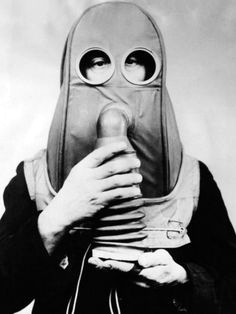Prior to the introduction of the clean air act of 1956, the air quality in the UK was, to say the least, not exactly fantastic. The vast numbers of slums found in the cities around the country meant that a large number of the poorer population was exposed to the diseases which flourished in such conditions; tuberculosis was rife in some areas. Add to the mix Great War veterans who had been directly exposed to the various gases used on the battlefield (and the respiratory issues they caused), and there was a clear need for a special gas mask to provide protection for anyone unable to use a normal gas mask.

Photograph above shows the mask being worn in Esher High Street in 1940.
It is important to understand that, while this was clearly a problem, it did not affect a substantial section of the population. Gas casualties had accounted for only 7% of the entire dead and wounded across all nations during the Great War; while this was a small percentage, the sheer numbers of casualties of the conflict still makes this a sizeable number.

The concept of the invalid's gas mask was simple enough; the standard masks were tight-fitting and as such, prolonged wear could render the user incapable of being able to breathe. The design allowed the user to be protected by an enveloping cover, which could be kept at a positive pressure compared to that outside of the mask by virtue of the pump located on the front. The wearer could continue to breathe normally and be less prone to any actual attack, which, when using a normal mask, could force the user to remove the mask in panic. Recently, it has been made known that the filters of WW2 gas masks contain asbestos; because of this you should NEVER wear a mask and consult a professional for SAFE DISPOSAL in the event of the mask becoming damaged.
Recently, it has been made known that the filters of WW2 gas masks contain asbestos; because of this you should NEVER wear a mask and consult a professional for SAFE DISPOSAL in the event of the mask becoming damaged.

Photograph above shows the mask being worn in Esher High Street in 1940.
It is important to understand that, while this was clearly a problem, it did not affect a substantial section of the population. Gas casualties had accounted for only 7% of the entire dead and wounded across all nations during the Great War; while this was a small percentage, the sheer numbers of casualties of the conflict still makes this a sizeable number.

The concept of the invalid's gas mask was simple enough; the standard masks were tight-fitting and as such, prolonged wear could render the user incapable of being able to breathe. The design allowed the user to be protected by an enveloping cover, which could be kept at a positive pressure compared to that outside of the mask by virtue of the pump located on the front. The wearer could continue to breathe normally and be less prone to any actual attack, which, when using a normal mask, could force the user to remove the mask in panic.
 Recently, it has been made known that the filters of WW2 gas masks contain asbestos; because of this you should NEVER wear a mask and consult a professional for SAFE DISPOSAL in the event of the mask becoming damaged.
Recently, it has been made known that the filters of WW2 gas masks contain asbestos; because of this you should NEVER wear a mask and consult a professional for SAFE DISPOSAL in the event of the mask becoming damaged.